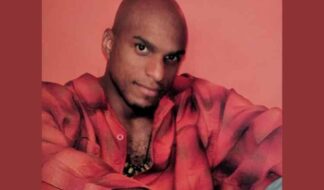By Gwendolyn Ann Smith

Something magical happened in my life late in the evening of the 14th of December, 1979. For years, I had been used to watching the television in my parents' front room quietly every Saturday evening, watching "Saturday Night Live" into the wee hours. It was a ritual of mine from the first season well into the show's much leaner 1980s years.
The guest that night was Martin Sheen, and while I can recall a couple of the comedy skits that night, they did not even remotely have the lasting impact that the musical guest would.
Performing that night was David Bowie, who played three tracks that night. Most point to his performance of "The Man Who Sold The World" as the highlight of the night, or perhaps his puppet-like performance of the then-current single, "Boys Keep Swinging." It was his first track, however, that would forever change the mind of this one young kid living in the suburbs.
I had heard of, and heard the music of, Bowie before that night. You could not avoid tracks like "Space Oddity" on the rock radio stations of the time. I enjoyed the song well enough, but it was just another tune blaring out of my yellow Panasonic Panapet.
Bowie's first performance that night was the song "TVC 15," a sci-fi story about a man whose wife ended up trapped inside a holographic television set. At the time, though, I had no idea of the story behind the song: all I had was the spectacle unfolding on my television screen.
Front and center was David Bowie, who hit the microphone wearing a bluish-gray men's style top and matching A-line skirt, while one backup singer pantomimed walking a bright pink poodle — with a television screen embedded in it — as the other pretended to read a newspaper. They too wore skirted outfits: one in black and the other in red.
I would later learn that these two were Klaus Nomi, a countertenor known for avant-garde musical performances, and Joey Arias, a cabaret singer and drag artist.
I had by this point in my life already gained a rudimentary idea of what being transgender was, though my knowledge was — to say the least — very limited, and focused largely on transsexuality. The notion that someone could wear an outfit like that while still appearing male, and be celebrated, was mind-blowing. It was simply nothing I'd ever heard of back in '79.
Over the ensuing years, of course, my knowledge of things trans grew by leaps and bounds, as did my knowledge of David Bowie. I went through a very heavy Ziggy Stardust period, two and a half decades after Bowie had hung up the platform boots and pancake makeup, spending my idle hours poring over his lyrics and style both.
At the time, I was hip-deep in my own gender transition, and took a lot of strength from listening to, amongst other things, David Bowie's many albums. "Life on Mars" gave me life, while "Rebel Rebel" gave me the power to make it out the other side.
That coincided with when I first started to write for the Bay Area Reporter in 2000, and needing a name for my column, I reached back to that moment in 1979, as Bowie sang the two-word chorus for "TVC 15": "Transition/Transmission."
So Transmissions it is to this day, thanks again to that one moment where David Bowie opened my eyes and showed me a world I never imagined existed.
That he was in a blouse and skirt for his SNL performance was a bit of a lark, concocted after Arias and Nomi found their matching dresses on a pre-show shopping spree. It wasn't anywhere near the first time that Bowie would challenge gender, having started with cross-gender presentation on the covers for "Hunky Dory" and "The Man Who Sold The World."
He did these one better for the arrival of one of his best-known personas, that of Ziggy Stardust. With a shock of bright red hair and a face full of makeup, his platform boot-and-jumpsuit wearing androgynous space alien trod into the heart of a generation of fans who felt out of place. He embodied the outsider — and doubly so for anyone who felt alienated due to their gender or sexuality.
This continued into his Aladdin Sane character, with the now-iconic lightning-bolt-across-the-eye makeup. Even to the end, Bowie seemed to exist in a place beyond traditional gender roles, or, more succinctly, in an identity that existed by his own rules.
He would appear in female personas in the video for "Boys Keep Swinging" as well as the 2013 clip for "The Stars (Are Out Tonight)," crossing personas and characters with the equally androgynous actress Tilda Swinton. That video also featured Andreja Pejic, a transgender model.
Bowie is gone now, taken from this planet on the 10th of January. He's yet another victim of cancer, gone too soon from this place.
In the wake of his passing, many have commented on how everyone has their "own" Bowie, much like how fans of the television series "Doctor Who" have a preferred actor for the eponymous lead character.
I wish I could claim it was the androgynous Ziggy Stardust that started me off as a fan, with his golden moon disk and flaming red hair, as well as his fluid sexual and gender identities.
For me, though, it will always be the Bowie who invaded my television set that December long ago.
Godspeed, Starman.










